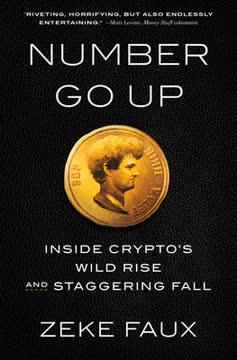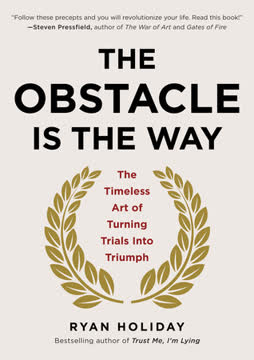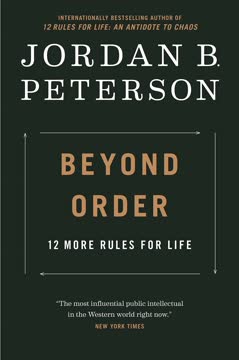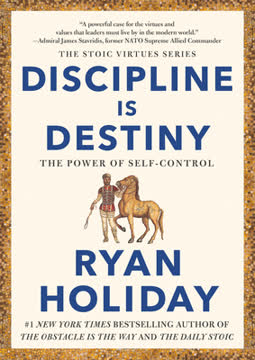Key Takeaways
1. The Self We Know Is a Left-Brain Illusion.
WHY ARE YOU UNHAPPY? BECAUSE 99.9 PERCENT OF EVERYTHING YOU THINK, AND OF EVERYTHING YOU DO, IS FOR YOURSELF—AND THERE ISN’T ONE.
Neuroscience meets Buddhism. Recent findings in neuropsychology, particularly studies on split-brain patients, align with the ancient Buddhist doctrine of anatta or "no self." The persistent feeling of a stable, continuous "me" is largely a story generated by the left side of the brain, acting as an "interpreter" to make sense of the world. This narrative self, while convincing, is ultimately an illusion.
Root of suffering. This misidentification with the false sense of self is presented as the fundamental cause of almost all human anxiety, depression, and fear. The thinking mind creates the idea of a self and then generates problems that arise from this fictional entity. Recognizing the self as an illusion reveals that many of the problems it creates are also illusory fabrications.
Beyond the thinking mind. Our true essence, or "clear consciousness," exists beyond the limitations of this thinking mind and its self-story. The goal is to disidentify with the false self and reconnect with this clear consciousness, which is grounded in the present moment and offers inner peace and a different way of seeing the world.
2. The Left Brain Interprets, Invents, and Confirms Its Stories.
The left brain was simply making up interpretations, or stories, for events that were happening in a way that made sense to that side of the brain (a shovel is needed for a chicken coop) or as if it had directed the action (I got up because I needed a drink, or I laughed at my own joke).
The Interpreter Module. Split-brain studies by Gazzaniga revealed that the left brain constantly creates explanations and reasons to interpret reality, even when given incomplete information. It acts as an "interpreter," weaving plausible but often incorrect stories to maintain a sense of coherence. This happens automatically and with absolute confidence.
Confirmation Bias. The mind, like a fortune-teller, first creates a theory about reality and then actively seeks information to confirm it, often ignoring contradictory evidence. This "confirmation bias" is a core mechanism of the thinking mind, making its interpretations feel undeniably true, even when they are based on limited or fabricated facts. Examples include:
- Assuming the next number in a sequence is 8 (2, 4, 6, ?) without considering other patterns.
- Assuming Joe needs glasses to read a menu, rather than admitting "My mind doesn't know."
- Believing a coworker dislikes you and only noticing evidence that supports this.
Stories of "Me". The most significant story the left brain tells is the story of "you." It interprets past events, current sensations, and future possibilities through the lens of this self-narrative. Just like the split-brain patient's explanations, these self-stories are often plausible fictions based on incomplete information, yet we believe them without question.
3. The Thinking Mind Is Lazy and Prone to Errors.
The mind has a certain built-in laziness.
Path of least resistance. The thinking mind, evolved to conserve energy for survival, prefers paths that require minimal effort. This inherent laziness leads it to take shortcuts, rely on assumptions, and avoid complex logical processing, especially when there's no immediate personal consequence for being wrong.
Logical Fallacies. This laziness manifests in predictable errors in reasoning, such as:
- Ad Hominem: Attacking the person rather than the argument itself, because it's easier to categorize the individual than evaluate complex ideas.
- Ignoring Base Rates: Failing to factor in the overall frequency of something in the population when evaluating probabilities (e.g., overestimating the chance of a rare disease after a positive test).
- Overestimating Self: Consistently judging oneself as "a little above average" in various traits to avoid the discomfort of cognitive dissonance.
Cognitive Dissonance. The mind works hard to maintain consistency between thoughts, behaviors, and feelings, avoiding the pain of being inconsistent or wrong. It will create elaborate justifications or ignore facts (like the Heaven's Gate cult dismissing a telescope) rather than admit a mistake, demonstrating its preference for comfort over accuracy.
4. Cultivate Awareness and Embrace the "Don't Know" Mind.
When we open ourselves to not knowing, we begin to experience the world in the present moment as it is, rather than how we are judging or expecting it to be.
Antidote to Laziness. Awareness, connected to the present moment and the right brain, serves as a reliable antidote to the mind's laziness and its tendency to create problems. It allows us to observe the thinking mind's operations without getting caught up in them.
The "Don't Know" Mind. Zen practice encourages embracing a state of "don't know." By contemplating questions impossible for the thinking mind to answer (like "What is the sound of one hand clapping?"), we sit in discomfort and create distance from the mind's automatic interpretations. This practice helps us:
- See the mind's limitations.
- Reduce reliance on ready answers.
- Experience immediacy in the present moment.
Observing Thoughts. Instead of trying to stop thinking, which is impossible, we can become the observer of our thoughts. Recognizing thoughts as impersonal electrochemical reactions allows us to free ourselves from the suffering they cause. This shift from identifying with thoughts to observing them is crucial for lessening their influence.
5. Access Right-Brain Wisdom Beyond Verbal Thought.
The left brain Gets Fooled, the Right Brain Gets Wise.
Different Ways of Knowing. While the left brain excels at language, logic, and sequential processing, the right brain offers a different, often wiser, way of knowing. It processes information holistically, non-verbally, and is more connected to visual perception, spatial awareness, and the present moment.
Bypassing the Left Brain. Techniques like upside-down drawing, inspired by Betty Edwards's work, demonstrate how to bypass the left brain's tendency to name and categorize, allowing the right brain's accurate visual perception to take over. The left brain gives up when presented with tasks it deems "useless," opening the door for the right brain.
Expanded Attention. The right brain maintains a wide, holistic attention span, taking in the "big picture," while the left brain uses a narrow, intense "spotlight" focus. Learning to notice what we don't notice, or enlisting others (like children or pets) to point out details, helps expand our attention beyond the left brain's limited scope.
6. Categories and Abstractions Are Mental Fictions, Not Reality.
To believe in categories, you must ignore a lot and pay attention to only a little.
Mental Boxes. The left brain constantly translates the real world into abstract mental categories or "boxes." This is a core cognitive skill, but it detaches us from physical reality and leads us to mistake these mental fictions for truth. Categories require ignoring vast amounts of unique information to focus on a few shared features.
Problems with Categorization. This habit creates numerous issues:
- Stereotypes: Reducing complex individuals to simple labels based on group membership (age, race, gender, etc.), ignoring their uniqueness.
- Judging: Making quick, often incorrect, probabilistic judgments based on stereotypes rather than statistical reality (e.g., the bank teller/poet puzzle).
- Conflict: Wars and social conflicts are often fought over abstract categories like countries or group identities, which exist only in the mind.
Falling Out of Love with Abstraction. Modern society is saturated with abstractions (money, social media "friends," even fake plants) that the mind prefers because they are easier to process than reality. Recognizing that categories are mental constructs, not real things, is crucial for seeing beyond the mind's illusions and appreciating the unique, ever-changing nature of reality.
7. Memories Are Reconstructions Used to Build the Illusory Self.
Your memory is only a story of a story of a story. In fact, none of your memories ever happened.
Memory and Self-Identity. Memory is fundamental to the creation of the illusory self. Autobiographical memories, which link events to a specific time and place ("this happened to me"), form the chain of events that establishes our sense of identity and personality. Without these memories, the self dissolves, as seen in cases like Henry Molaison (H.M.).
Memories Are Not Facts. Cognitive science shows that memory is not like replaying a video. Memories are biased interpretations and reconstructions of what we think happened, heavily influenced by our beliefs, social conditioning, and even later information. They change and shift over time.
- The office experiment showed people "remembered" books that weren't there.
- Eyewitness testimony is notoriously unreliable, leading to wrongful convictions.
Suffering from the Past. Much suffering arises from replaying these distorted memories and projecting them onto the future (regret, anxiety). The illusory self persists by clinging to these past narratives, even if they cause pain, because it would rather exist in suffering than face the unknown freedom of no self.
8. The Mind Is a Problem Creator, Not Just a Solver.
First-world problems are all due to the mind—that’s it.
Expanding the "Problem" Category. While the mind evolved to solve real survival problems, in modern, relatively secure environments, it keeps busy by inventing problems. It expands the category of "problem" to find things to fix, even when basic needs are met. This is the source of "first-world problems."
Problem Inflation. Studies show that when real problems become scarce, the mind redefines what constitutes a problem to ensure there's always something to focus on. Subjects in experiments started seeing non-threatening faces as threatening or redefining ethical standards when fewer unethical proposals were presented. This happens even when people are told it will occur.
Inside Job. Suffering often arises not from external circumstances but from the mind's interpretation and categorization of those circumstances as "bad" or "wrong." The mind's tendency to focus narrowly on perceived flaws (like the red dot on the sweater in Seinfeld) can ruin an otherwise positive experience.
9. Desire and Habituation Fuel Endless Seeking and Suffering.
If we allow the thinking mind to govern our lives, no matter how good it gets there will be no end to the search for something better.
The Cycle of Wanting. The Buddha identified desire as a primary source of suffering. The thinking mind, driven by habituation, quickly gets used to gains (winning the lottery, new possessions) and returns to its baseline level of happiness, immediately seeking something new or better. This creates a never-ending cycle of wanting.
Habituation's Double Edge. Habituation, the process of getting used to repeated stimuli, is essential for survival (ignoring constant background noise). It helps us cope with loss, making even catastrophic events eventually feel "normal." However, it also makes us take gains for granted, preventing lasting contentment.
Marketing and Scarcity. Modern marketing exploits the mind's compulsion to seek more by creating a sense of scarcity, not just of possessions, but of inner worth. It convinces us we are not enough and need external solutions, fueling endless desire and preventing us from recognizing the abundance already present.
10. Let Go of Control; Embrace Allowing and Acceptance.
Balance is almost never achieved through control, at least not for very long.
The Paradox of Control. The thinking mind often tries to control internal states (thoughts, emotions, sleep) and external outcomes, especially in high-stakes situations. However, this effort often backfires, leading to increased anxiety, insomnia, or poor performance ("choking"). Trying not to think about something makes you think about it more.
Wu Wei and No Effort. Taoist philosophy offers the concept of wu wei or "no effort," suggesting that balance and harmony are achieved not through forceful control but through allowing things to take their natural course. This contrasts with the mind's tendency to create conflict by insisting on a particular outcome.
Allowing Emotions. Instead of suppressing or running from difficult emotions, allowing and accepting them can paradoxically cause them to fade more quickly. This "paradoxical intention" (Frankl) works because it removes the mind's struggle to control, letting the emotion move through the body naturally.
11. Trust the Wisdom of Feelings and the Embodied Self.
Virtually all wisdom teachings value feelings over thoughts, as long as the feelings are not out of fear.
Emotions as Communication. Emotions are an older, more fundamental system than the thinking mind, driving much of our experience and communication (facial expressions, tone of voice). While the mind can only process one thought at a time, we can experience multiple, conflicting emotions simultaneously, reflecting a more sophisticated intelligence.
Beyond IQ. Wisdom traditions often value feelings and bodily knowing (EQ, BQ) over purely intellectual knowing (IQ). The Taos Pueblo elder's insight that Europeans "think with their heads" while his people "think here" (indicating the heart) highlights this difference. Emotions provide meaning and drive important decisions.
Whole-Body Yes. Learning to tune into bodily sensations and emotions can provide intuitive guidance beyond the mind's rationalizations. Practices like the "whole-body yes" involve checking in with thoughts, emotions, and physical feelings to discern a clear direction, building trust in this deeper, integrated intelligence.
12. Bypass the Mind Through Practice and Direct Experience.
Consciousness isn’t a mystery to be solved but an experience to be had.
Experience Over Thought. The limitations of the thinking mind cannot be overcome by more thinking. The path to clear consciousness and disidentifying with the self lies in direct experience and practice, not intellectual understanding. Just as you can't think your way to a better golf swing, you can't think your way to enlightenment.
Practices for Disidentification:
- Breathing: Focusing on breath grounds you in the present moment, bypassing the thinking mind.
- Somatic Practices: Tuning into bodily sensations (body scans, box breathing) integrates mind and body, reducing mental chatter.
- Connecting with Earth: Grounding practices (walking barefoot) quiet the left brain and connect you to organic reality.
- Rituals: Conscious, repeated behaviors involving the body and elements create meaningful experiences beyond mental comprehension.
- Randomness: Introducing novelty (random word generators, flipping coins) disrupts the mind's predictable patterns and sparks new connections.
- Music: Engaging with music activates the whole brain and provides a break from the thinking mind, tapping into a deeper, non-verbal language of consciousness.
Waking from the Dream. Recognizing that our thoughts and perceptions are interpretations, not reality, is like waking from a dream. The "dream of thinking" makes us take abstract thoughts seriously, causing suffering. By engaging in practices that bypass or observe the thinking mind, we can experience reality directly, realizing that consciousness itself is the fundamental reality, not the mind's illusory constructs.
Last updated:
Review Summary
The No Self, No Problem Workbook receives mostly positive reviews, with readers praising its practical exercises for experiencing "no-self" and balancing left and right brain functions. Many find it helpful for mindfulness and reducing mental suffering. Reviewers appreciate the book's accessibility and its ability to change perspectives on thinking patterns. Some note it works well as a standalone or companion to the original book. Critics mention redundancy for those familiar with the first book and occasional disorganization, but overall, readers find it insightful and transformative.
Similar Books










Download PDF
Download EPUB
.epub digital book format is ideal for reading ebooks on phones, tablets, and e-readers.





